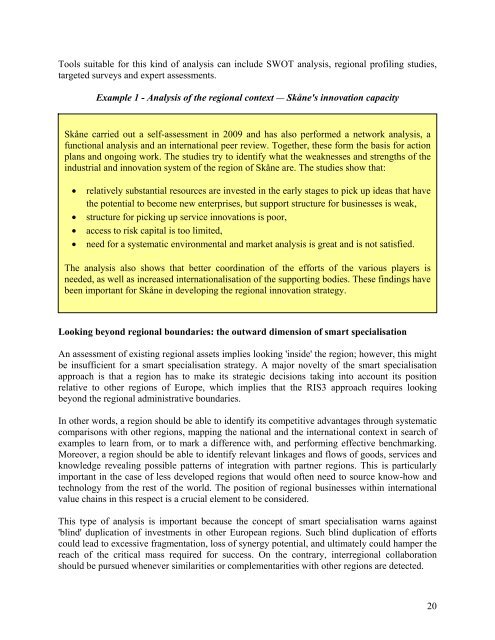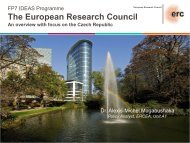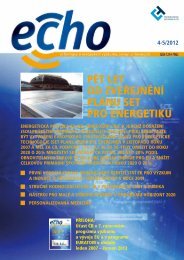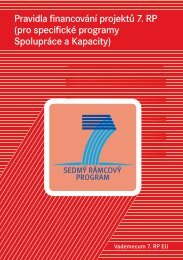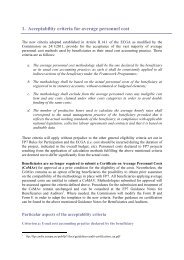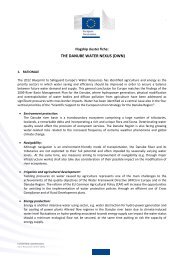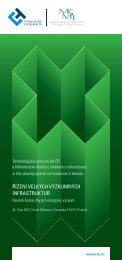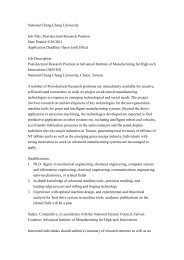Guide to Research and Innovation Strategies for Smart Specialisation
Guide to Research and Innovation Strategies for Smart Specialisation
Guide to Research and Innovation Strategies for Smart Specialisation
Create successful ePaper yourself
Turn your PDF publications into a flip-book with our unique Google optimized e-Paper software.
Tools suitable <strong>for</strong> this kind of analysis can include SWOT analysis, regional profiling studies,<br />
targeted surveys <strong>and</strong> expert assessments.<br />
Example 1 - Analysis of the regional context — Skåne's innovation capacity<br />
Skåne carried out a self-assessment in 2009 <strong>and</strong> has also per<strong>for</strong>med a network analysis, a<br />
functional analysis <strong>and</strong> an international peer review. Together, these <strong>for</strong>m the basis <strong>for</strong> action<br />
plans <strong>and</strong> ongoing work. The studies try <strong>to</strong> identify what the weaknesses <strong>and</strong> strengths of the<br />
industrial <strong>and</strong> innovation system of the region of Skåne are. The studies show that:<br />
• relatively substantial resources are invested in the early stages <strong>to</strong> pick up ideas that have<br />
the potential <strong>to</strong> become new enterprises, but support structure <strong>for</strong> businesses is weak,<br />
• structure <strong>for</strong> picking up service innovations is poor,<br />
• access <strong>to</strong> risk capital is <strong>to</strong>o limited,<br />
• need <strong>for</strong> a systematic environmental <strong>and</strong> market analysis is great <strong>and</strong> is not satisfied.<br />
The analysis also shows that better coordination of the ef<strong>for</strong>ts of the various players is<br />
needed, as well as increased internationalisation of the supporting bodies. These findings have<br />
been important <strong>for</strong> Skåne in developing the regional innovation strategy.<br />
Looking beyond regional boundaries: the outward dimension of smart specialisation<br />
An assessment of existing regional assets implies looking 'inside' the region; however, this might<br />
be insufficient <strong>for</strong> a smart specialisation strategy. A major novelty of the smart specialisation<br />
approach is that a region has <strong>to</strong> make its strategic decisions taking in<strong>to</strong> account its position<br />
relative <strong>to</strong> other regions of Europe, which implies that the RIS3 approach requires looking<br />
beyond the regional administrative boundaries.<br />
In other words, a region should be able <strong>to</strong> identify its competitive advantages through systematic<br />
comparisons with other regions, mapping the national <strong>and</strong> the international context in search of<br />
examples <strong>to</strong> learn from, or <strong>to</strong> mark a difference with, <strong>and</strong> per<strong>for</strong>ming effective benchmarking.<br />
Moreover, a region should be able <strong>to</strong> identify relevant linkages <strong>and</strong> flows of goods, services <strong>and</strong><br />
knowledge revealing possible patterns of integration with partner regions. This is particularly<br />
important in the case of less developed regions that would often need <strong>to</strong> source know-how <strong>and</strong><br />
technology from the rest of the world. The position of regional businesses within international<br />
value chains in this respect is a crucial element <strong>to</strong> be considered.<br />
This type of analysis is important because the concept of smart specialisation warns against<br />
'blind' duplication of investments in other European regions. Such blind duplication of ef<strong>for</strong>ts<br />
could lead <strong>to</strong> excessive fragmentation, loss of synergy potential, <strong>and</strong> ultimately could hamper the<br />
reach of the critical mass required <strong>for</strong> success. On the contrary, interregional collaboration<br />
should be pursued whenever similarities or complementarities with other regions are detected.<br />
20


